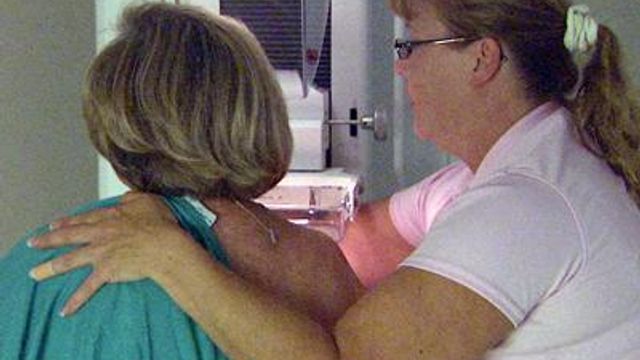New mammogram guidelines cause confusion
A government panel suggests that most women in their 40s should not routinely get mammograms.
Posted — UpdatedBut the government panel of doctors and scientists concluded that getting screened for breast cancer so early and so often leads to too many false alarms and unneeded biopsies without substantially improving women's odds of survival.
"The benefits are less and the harms are greater when screening starts in the 40s," said Dr. Diana Petitti, vice chair of the panel.
The new guidelines were issued by the U.S. Preventive Services Task Force, whose stance influences coverage of screening tests by Medicare and many insurance companies. But Susan Pisano, a spokeswoman for America's Health Insurance Plans, an industry group, said insurance coverage isn't likely to change because of the new guidelines.
“It flies in the face of not only their own previous recommendations, but those of several other major national, international, professional organizations,” said Dr. Gary Lyman, a breast oncologist at Duke Hospitals.
Lyman participates in guidelines work with several different medical boards and societies. He fears the panel's recommendations will only confuse women.
“We know when confusing recommendations have come out in the past, it's led to a downturn in the use of services,” Lyman said.
"Our concern is that as a result of that confusion, women may elect not to get screened at all. And that, to me, would be a serious problem," said Dr. Len Lichtenfeld, the cancer society's deputy chief medical officer.
The guidelines are for the general population, not those at high risk of breast cancer because of family history or gene mutations that would justify having mammograms sooner or more often.
The new advice says:
- Most women in their 40s should not routinely get mammograms.
- Women 50 to 74 should get a mammogram every other year until they turn 75, after which the risks and benefits are unknown. (The task force's previous guidelines had no upper limit and called for exams every year or two.)
- The value of breast exams by doctors is unknown. And breast self-exams are of no value.
Medical groups such as the cancer society have been backing off promoting breast self-exams in recent years because of scant evidence of their effectiveness. Decades ago, the practice was so heavily promoted that organizations distributed cards that could be hung in the shower demonstrating the circular motion women should use to feel for lumps in their breasts.
The guidelines and research supporting them were released Monday and are being published in Tuesday's issue of the Annals of Internal Medicine.
The new advice was sharply challenged by the cancer society.
"This is one screening test I recommend unequivocally, and would recommend to any woman 40 and over," the society's chief medical officer, Dr. Otis Brawley, said in a statement.
The task force advice is based on its conclusion that screening 1,300 women in their 50s to save one life is worth it, but that screening 1,900 women in their 40s to save a life is not, Brawley wrote.
That stance "is essentially telling women that mammography at age 40 to 49 saves lives, just not enough of them," he said. The cancer society feels the benefits outweigh the harms for women in both groups.
International guidelines also call for screening to start at age 50; the World Health Organization recommends the test every two years, Britain says every three years.
Breast cancer is the most common cancer and the second leading cause of cancer deaths in American women. More than 192,000 new cases and 40,000 deaths from the disease are expected in the U.S. this year.
Mammograms can find cancer early, and two-thirds of women over 40 report having had the test in the previous two years. But how much they cut the risk of dying of the disease, and at what cost in terms of unneeded biopsies, expense and worry, have been debated.
In most women, tumors are slow-growing, and that likelihood increases with age. So there is little risk by extending the time between mammograms, some researchers say. Even for the minority of women with aggressive, fast-growing tumors, annual screening will make little difference in survival odds.
The new guidelines balance these risks and benefits, scientists say.
The probability of dying of breast cancer after age 40 is 3 percent, they calculate. Getting a mammogram every other year from ages 50 to 69 lowers that risk by about 16 percent.
"It's an average of five lives saved per thousand women screened," said Georgetown University researcher Dr. Jeanne Mandelblatt.
Starting at age 40 would prevent one additional death but also lead to 470 false alarms for every 1,000 women screened. Continuing mammograms through age 79 prevents three additional deaths but raises the number of women treated for breast cancers that would not threaten their lives.
"You save more lives because breast cancer is more common, but you diagnose tumors in women who were destined to die of something else. The overdiagnosis increases in older women," Mandelblatt said.
She led six teams around the world who used federal data on cancer and mammography to develop mathematical models of what would happen if women were screened at different ages and time intervals. Their conclusions helped shape the new guidelines.
Several medical groups say they are sticking to their guidelines that call for routine screening starting at 40.
"Screening isn't perfect. But it's the best thing we have. And it works," said Dr. Carol Lee, a spokeswoman for the American College of Radiology. She suggested that cutting health care costs may have played a role in the decision, but Petitti said the task force does not consider cost or insurance in its review.
• Credits
Copyright 2024 by WRAL.com and the Associated Press. All rights reserved. This material may not be published, broadcast, rewritten or redistributed.





